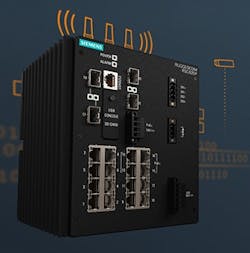RuggedCom designs and builds high-quality networking and communication products for various industries and has had much success in the utility side of things.
I’m a software guy, so, when I was invited to Siemens’ RuggedCom plant tour, I was intrigued, as well as excited to see what these guys were doing.RuggedCom started as a Canadian innovation story in 2002. It grew quickly and found the eye of Siemens in 2012. The plant is located in Concord, Ontario. RuggedCom designs and builds high-quality networking and communication products for various industries and has had much success in the utility side of things. Its offerings dovetail into the idea of the smart grid very well.
The initial meet and greet was initiated by Joerg Freitag, general manager of RuggedCom. To illustrate the impact of its products in the industrial space, he showed a video of an open-frame Ethernet switch in operation while the Navy ship where it was located shot off some large-caliber rounds. Boom! The boards in the switch actually flexed. It was incredible, really. And the device kept working. That got my attention quickly.
RuggedCom builds two levels of equipment—one that meets the IEC 61850-3 environmental and survivability requirements and another, the Scalance line, which is still industrial, but you could consider it RuggedCom Lite.
Mohamed Hamawi, head of production and engineering, was our tour guide. All of RuggedCom’s orders are custom-built, he told us. Why? There are in excess of 10,000 different combinations of configurable components that can create “your” device. Switches, modems, routers, and wireless all fit into the possibilities.
The plant floor is electrostatic-discharge (ESD) aware, so anyone going past the entry turnstile must have conductive strips on the soles of their shoes and test themselves before they are allowed to enter. As we know ESD can wound a chip, so in-field failures can happen prematurely, and that isn’t good.
Regarding delivery and costs, 10 days is average, and costs vary due to the varied configurations, so the targets move. By comparison, a Layer 2 switch cost is about 30% higher than a normal Cisco switch, but the RuggedCom switch can live on a Navy vessel.
The operating system in the devices is called ROX. With some basic training, all departments can support and configure the devices. All chip sets are industrial-temperature-specified. They have to be to meet the IEC standard.
All component boards are stuffed off-site using third-party companies. The testing of the component boards is done before landing, so in fact RuggedCom is more of an assembly operation, but with 100% test. It puts all devices through highly accelerated life testing (HALT) and highly accelerated stress screening (HASS).
This provides an average specification of 2 million hours for mean time between failures (MTBF). With HALT/HASS testing, the specifications are stretched to take the devices through temperature ranges between -90 and 200 °C and six-axis vibration up to 80 g of force, so the testing isn’t gentle.
If there’s a bad apple, this testing procedure will raise that flag.
Once this testing level is completed, the devices are fully tested for function. This will determine that each Ethernet port is working at the various speeds and other measurements, and then the product is boxed.
A further step occurs when an audit procedure requires the quality-control department to remove the device in a random box and test it again to be sure the product is what the customer ordered.
The main cause of customer returns occurs when the device isn’t configured as ordered, which Hamawi explained doesn’t happen often.
I was impressed with the designs and the way Ruggedcom implements new product designs on the floor, as well as longevity testing of new designs.
The product line is comprehensive and supports Wi-Fi and cell communications, as well as wired. Components are hot-swappable, which may be important in mission-critical applications. As we all know, things happen and things fail, but RuggedCom really makes a big effort in making sure its designs, testing, software and assembly meet the customers’ expectations when the product arrives on their doorsteps.
Software is becoming more prevalent in the business and is wide-ranging, using embedded operating systems and standard Microsoft Windows platforms.






